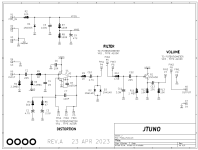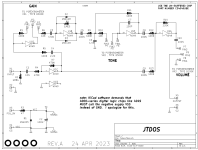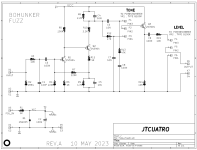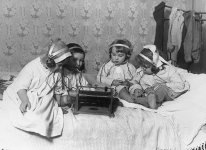Yes, and while there are several reasons why, perhaps, the primary reason is that there is another equally, or more compelling, competing home entertainment option, which consumes the bulk of the entertainment budgets of young people. Which is, sophisticated video gaming. While music listening is still included in daily activities, it’s often as a background accompaniment to other activities. I suspect that has always been the case since there has been recorded music, but it feels like it’s much more so today.
Haha - I thought you ment humanity as it was the lounge... if its still about audio then it should her gone to "Everything Else"... 😉Not dying but probably we have reach a population peak in terms of numbers. Hopefully 😉
//
//
Let’s factor in the payoff.
When I built my first speakers in 1983 it was because the $200 speakers I wanted were far out of my reach, so I built something that sounded just as good for $80. That was in 1983 dollars.
Back then for a total expense of $300 I got a 20 W receiver, a pair of two-way speakers I made myself, and a turntable. If you were into technological stuff at the time, a good stereo was somewhere near the top of the heap. Computers hadn’t quite caught on yet.
That audio system by today’s standards would sound sort-of OK, and that’s only if you’re into nostalgia and vinyl.
Today for $300 in 2024 dollars (which are 4X easier to get than ‘83 dollars) the music streams out of my phone which I already have, I can get a 50 W per channel amplifier for about 80 bucks and if I have $200 left for speakers, I can find something QUITE good either new or used. A comparable sounding system in the mid 80s would’ve required a CD player and a pretty good receiver and would’ve cost close to $1000. And I would’ve had to buy every CD for $12 instead of getting all the music in the world for $15 a month.
In other words, a hour of wages buys 10 times as much bang for buck today as it did back then. Getting great sound for a little bit of money is not at all difficult. Doesn’t require DIY.
I still build a lot of speakers and I only do it for the fun of it. It’s because I have deep knowledge of the subject, and I’m exploring a space I’m fascinated with, probably for somewhat neurotic reasons. I don’t really do it because it’s cheaper or because it’s efficient use of my time.
Now… The one place where it is highly cost-effective is when you are building high-end speakers AND you know exactly what you’re doing. The Bitches Brew speakers which I’ve written about in other threads cost $5000-$6000 to make, including outsourcing the cabinet work to a professional carpenter. You’d have to spend a bare minimum of $75,000 at AXPONA to get something as good. Probably over $100,000.
We are all products of the times and circumstances we grew up in and what we invested our time in mastering. Today, a lot of people make stuff, but it’s raspberry pi and software and gaming. My kids are into Minecraft, dungeons and dragons, music recording and production, piano and violin. And of course, creating videos on Instagram, YouTube and TikTok.
DIY is alive and well, and it takes MANY forms.
When I built my first speakers in 1983 it was because the $200 speakers I wanted were far out of my reach, so I built something that sounded just as good for $80. That was in 1983 dollars.
Back then for a total expense of $300 I got a 20 W receiver, a pair of two-way speakers I made myself, and a turntable. If you were into technological stuff at the time, a good stereo was somewhere near the top of the heap. Computers hadn’t quite caught on yet.
That audio system by today’s standards would sound sort-of OK, and that’s only if you’re into nostalgia and vinyl.
Today for $300 in 2024 dollars (which are 4X easier to get than ‘83 dollars) the music streams out of my phone which I already have, I can get a 50 W per channel amplifier for about 80 bucks and if I have $200 left for speakers, I can find something QUITE good either new or used. A comparable sounding system in the mid 80s would’ve required a CD player and a pretty good receiver and would’ve cost close to $1000. And I would’ve had to buy every CD for $12 instead of getting all the music in the world for $15 a month.
In other words, a hour of wages buys 10 times as much bang for buck today as it did back then. Getting great sound for a little bit of money is not at all difficult. Doesn’t require DIY.
I still build a lot of speakers and I only do it for the fun of it. It’s because I have deep knowledge of the subject, and I’m exploring a space I’m fascinated with, probably for somewhat neurotic reasons. I don’t really do it because it’s cheaper or because it’s efficient use of my time.
Now… The one place where it is highly cost-effective is when you are building high-end speakers AND you know exactly what you’re doing. The Bitches Brew speakers which I’ve written about in other threads cost $5000-$6000 to make, including outsourcing the cabinet work to a professional carpenter. You’d have to spend a bare minimum of $75,000 at AXPONA to get something as good. Probably over $100,000.
We are all products of the times and circumstances we grew up in and what we invested our time in mastering. Today, a lot of people make stuff, but it’s raspberry pi and software and gaming. My kids are into Minecraft, dungeons and dragons, music recording and production, piano and violin. And of course, creating videos on Instagram, YouTube and TikTok.
DIY is alive and well, and it takes MANY forms.
That is a positive view on matters 🙂 Maybe too positive as many see a decline. Technical educational also gets fewer students every year.
Last edited:
Fashions come and go. Against the odds, vinyl has had resurgence, and I suspect peoples affections for glowing tubes will endure. it's all about the experience today and if it looks better then it sounds better.
DiyAudio (in general not the forum) is rather niche and the Internet revolution has surely helped save the hobby from extinction by bringing the global community together. On the flip side, it wasn't on the school curriculum in my day and gather it still isn't today, so we're now left with a largely brain dead general population who don't have the time and even if they did (lock down) wouldn't know where to start.
The research data in the link is not representative for many reasons. Better to look at how well businesses in the trade are doing.
DiyAudio (in general not the forum) is rather niche and the Internet revolution has surely helped save the hobby from extinction by bringing the global community together. On the flip side, it wasn't on the school curriculum in my day and gather it still isn't today, so we're now left with a largely brain dead general population who don't have the time and even if they did (lock down) wouldn't know where to start.
The research data in the link is not representative for many reasons. Better to look at how well businesses in the trade are doing.
Last edited:
It is dying since the Walkman Sony and since MTV (early 80s'). People step by step evolved for the mass, towards less free space and home surfaces, more portability as they slided into a bubble and a conected world. They don't want only listen to music but want "liking" to know and share in a comunauty their tastes of the day. So now music is listened to with the eyes also ! Uh...
I read there was never as huge as this year, tons of headphones of all type solded.
Maybe also we soon rent our hifi to change it every 6 months or 3 years as we do with smartphones or cars. The money is streamed too.
But what to say of the hypsters with their LPs...
Hard to see a logic sometimes !
I read there was never as huge as this year, tons of headphones of all type solded.
Maybe also we soon rent our hifi to change it every 6 months or 3 years as we do with smartphones or cars. The money is streamed too.
But what to say of the hypsters with their LPs...
Hard to see a logic sometimes !
This thread has really got me thinking (thanks to all of you for that). I have two great-grandchildren who are going to get something like this from me.
https://sciplus.com/electronic-play...Ek35ZLsWCJrQmudSmM60EzDGcb9XQwqFWQ0jyr7GpJd5c
https://sciplus.com/electronic-play...Ek35ZLsWCJrQmudSmM60EzDGcb9XQwqFWQ0jyr7GpJd5c
Thanks grand Pa for the DJ mixing table... 😆 ("we had already learned some hip-hop scratching with the fingers with your LP12")
CWelshh52
I got a Philips electronic kit, something like that, one Christmas, and it started my career in electronics.
I got a Philips electronic kit, something like that, one Christmas, and it started my career in electronics.
I have two great-grandchildren who are going to get something like this from me...
Go for it!
My uncle, a radio operator in WW2, got me started off on this hobby at a very young age!
Attachments
My son (27 now) will soon have his first soldering iron, digital multimeter and lots of alligator clip wires. He’s in repairing and upgrading (electric) guitars and want to do more DIY. Together we just built a high end electric guitar according to his wishes. Earlier we built a pedal, a Marshall amplifier clone and a speaker cabinet.
So there is hope…
Regards, Gerrit
So there is hope…
Regards, Gerrit
@gerrittube My entry into DIY was building an electric guitar. I've now built or restored over a dozen and am currently working on my third acoustic. It's a fun hobby! Of course, a lot of my friends say things like, "why would you want to spend all that time and money when you can buy something already finished?" We all know the answer to that one, don't we?
Here are a few guitar pedals that I laid out as PCBs for a friend's kid. I don't think he fiddled around with them very much.
Gerbers for 2-layer PCBs are attached. You can view and investigate these Gerbers for free, without divulging your email address and without downloading any software apps, using the website http://www.pcbxprt.com . . . notice it's NOT https
_
- UNO is a copy of the RAT 2 , a much loved distortion pedal still manufactured and sold today
- DOS is a pedal circuit called "UBE Screamer" which employs CD4000 series logic gates and uses them as (crappy) amplifiers
- TRES is another distortion pedal
- CUATRO is a fuzz pedal
_
Attachments
-
 uno.png78.7 KB · Views: 68
uno.png78.7 KB · Views: 68 -
 dos.png93.1 KB · Views: 68
dos.png93.1 KB · Views: 68 -
 tres.png61.4 KB · Views: 65
tres.png61.4 KB · Views: 65 -
 cuatro.png71.6 KB · Views: 76
cuatro.png71.6 KB · Views: 76 -
Gerbers_Pedal_JTuno_RevA.zip42.8 KB · Views: 39
-
Gerbers_Pedal_JTdos_RevA.zip32.5 KB · Views: 37
-
Gerbers_Pedal_JTtres_RevA.zip39.7 KB · Views: 39
-
Gerbers_Pedal_JTcuatro_RevA.zip36.7 KB · Views: 46
This is just anecdotal, but in the early 70’s, it seemed like those pursuing engineering degrees started to wane after the ending of the Apollo missions. Then, they seemed to pick back up, after about 1980, with the advent of the computer revolution and information age. Today, falling back again. It seems that we need the emergence of another revolutionary technology in order to excite engineering educations once more. Imagine the interest, if the science and engineering behind UFO vehicles were discovered, just for as arbitrary, and radical example.That is a positive view on matters 🙂 Maybe too positive as many see a decline. Technical educational also gets fewer students every year.
the audio industry changes, sometimes rapidly and just like any tech industry every change leaves some behind and adds some new….it only dies when the reaction stops. With diminishing returns and the very high end keeping up a very high price point we must recognize that it’s not about sound any more then buying a Rolex is about keeping time. For many years we have been in an industry which is about arrogance and opulence or how good does it look and how smart am I for choosing this path? An audiophiles opinion is based on assumption and prejudice and our most subjective sense. This explains why the cult of the SINAD can be scientifically correct and so wrong at the same time. Nostalgia and the presumption of superior intelligence drives sales, may it continue to be so…
Hi Mark,
Thanks for posting info on your guitar pedals. Do you have any pictures?
I will discuss these with my son, as he’s the expert on this. He has dozen’s of pedals, including originals from the early 60’s and 70’s.
Regards, Gerrit
Thanks for posting info on your guitar pedals. Do you have any pictures?
I will discuss these with my son, as he’s the expert on this. He has dozen’s of pedals, including originals from the early 60’s and 70’s.
Regards, Gerrit
My children and grandchildren are too affluent to spend hours scrounging parts and tinkering with circuits the way I did. I built a killer ~fuzz box that was not so simple. The front end was a boot strapped pair of bjts with a limited gain to avoid clipping when not in fuzz mode. The bootstrap provided the high impedance required for an electric guitar and may have added a bit of H2. Distortion options were 1. a back-back pair of diodes to produce an effect like cross-over distortion, gives bass some funky character, or 2. a pair of transistors driven out of phase for 2x frequency multiplication, and a quenching scream when over driven. then I had 3 switched ~filters: 1. 3rd order high pass, 2. flat (attenuation), 3. low pass so you could mix these, and finally a wa-wa circuit that could be driven by a ~triangle oscillator or a foot pedal.
I leant it to a friend and forgot who. 50 years later I complained about it on FB and one of my FB friends admitted it was him and that he had used it for years in his band.
PS: Important: I spent a lot of time ~tuning the sound, ie the result was more about sound and not just electronics.
I leant it to a friend and forgot who. 50 years later I complained about it on FB and one of my FB friends admitted it was him and that he had used it for years in his band.
PS: Important: I spent a lot of time ~tuning the sound, ie the result was more about sound and not just electronics.
Last edited:
On Facebook, I've just seen a picture of Mark Levinson monoblocks, 2,400 watts per channel, driving 99dB/watt Tannoy Westminsters. I've seen many more pictures of McIntosh monster amps driving massive horns. High end seems to be more about racks and racks (and more racks) of equipment, with massive speakers, a show of excess and a pose, rather than a tool to enjoy music. I'd rather have a system that sounds good at low volumes, than deafen myself and suffer tinnitus for the rest of my life. Each to their own.arrogance and opulence or how good does it look and
When you want rave sound levels there is no substitute for a good PA system. Imaging, soundstage, total lack of distortion, etc. are just useless expensive distractions when the goal is simply energy. You can get it sounding pretty good with modern DSP, there isn’t much point in going further.
Most of the rest of the time 60 to 80 dB is plenty, or occasional nightclub levels in the shop while running power tools which are just as loud. I gave up on one system that will do it all. More excuses to build stuff. All of them are tools to enjoy music. Like having a skil saw (three of them actually), sawzall, a table saw, radial saw, jig saw, angle grinder, chop saw, and a band saw. Just pick out the right tool.
Most of the rest of the time 60 to 80 dB is plenty, or occasional nightclub levels in the shop while running power tools which are just as loud. I gave up on one system that will do it all. More excuses to build stuff. All of them are tools to enjoy music. Like having a skil saw (three of them actually), sawzall, a table saw, radial saw, jig saw, angle grinder, chop saw, and a band saw. Just pick out the right tool.
- Home
- Member Areas
- The Lounge
- Are we a dying breed?
